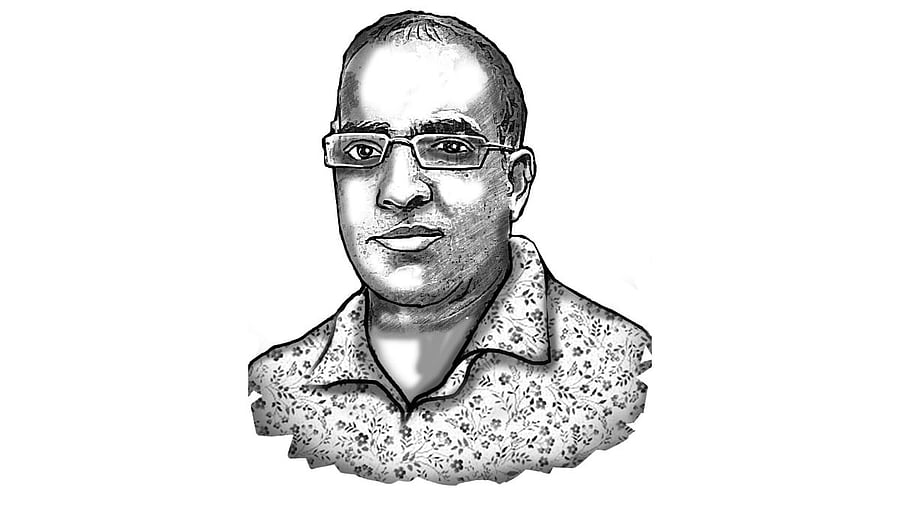
Ashwin Mahesh. Social technologist and entrepreneur, founder of Mapunity and co-founder, Lithium, wakes up with hope for the city and society, goes to bed with a sigh, repeats cycle X: @ashwinmahesh
Credit: DH Illustration
Kempegowda International Airport (KIA), located in the distant northeast of the Bengaluru metropolitan region, is inconvenient for residents and businesses in a significant portion of the city, particularly those in the southern suburbs. The incomplete Peripheral Ring Road is partly responsible for this, but as the city continues its sprawl outwards on Hosur Road, Sarjapura Road and Mysuru Road, KIA will continue to seem remote to millions of residents.
Those looking for a solution sometimes find hope in talk of an airport in Hosur, across the state border. Across the southern suburbs that together have more than 5 million residents, many would see that as a good option for their air travel needs. From Karnataka’s viewpoint, however, this would be a loss, as it would almost certainly drag much of the regional development into areas within Tamil Nadu, rather than within our state. This lack of an airport in the west and south is not the only transit deficit. South Bengaluru also does not have a major railway terminus. In fact, these things are part of a consistent pattern of uneven growth in different directions. While the east, north and south have experienced explosive development, the western and southwestern regions have lagged behind, creating a spatial disparity in economic opportunity and infrastructure.
What Bengaluru needs now is an integrated response to these multiple challenges – the relatively weaker growth in one half of the region, the lack of key air and rail infrastructure, and the sprawl towards borders rather than within Karnataka. The northeast is also more arid than the south-west, which means that future growth along the same lines as the past will put immense pressure on natural resources. The solution is in Bidadi.
At a distance of 32 km from the city, the town is almost exactly the same distance to the south-west of Bengaluru as KIA is to the northeast. If the second airport were to be located here, it would provide symmetry to air travel for residents in the city region, giving them reasonable access to one of the two airports regardless of where they live.
Bidadi is also in close proximity to key highways that either already exist or are under development. The Mysuru expressway and the NICE corridor pass close to the town. STRR too is within reach, and would connect to several towns throughout southeastern Karnataka. The Bidadi railway station, close to the Mysuru expressway, is now a small station at which a limited number of trains halt. If properly integrated into the rest of the city’s rail infrastructure and developed into a modern station like the one at Byappanahalli, it could easily become a terminus for train services to other parts of the country too.
During the last two decades, governments have announced plans for large-scale development around Bidadi. Not too far away is the Nadaprabhu Kempegowda Layout, the first BDA layout in a long time. A new satellite township near Harohalli was recently mooted. The proposal for a satellite township near Solur was also once spoken of. Along the NICE corridor, extensive lands were acquired to develop large new townships. Together, these developments could house up to three million residents. But these plans have all made slow progress.
By notifying these lands, the government has effectively blocked private property owners from developing them. As a result, the region has not seen growth in jobs. However, there is a baseline of factory jobs in this region. Large manufacturing companies have operations at the industrial township not far from Bidadi, and there are a few other industrial parks not too far away. On multiple counts, therefore – location within the city region, access to highways and rail lines, land for new development – the region around Bidadi is well suited for the second airport.
But beyond an airport, we must accelerate development of the stalled and slow housing plans in various layouts. An underground railway station at the new airport, also served by Namma Metro, would provide multi-modal connectivity. The airport must also be connected to the Mysuru Expressway, NICE Road, and the STRR. The responsibility for these projects is scattered across agencies – BDA, BWSSB, BMRDA, BMLTA and others. The Metropolitan Planning Committee, mandated by the Constitution, remains on paper. This kind of ad hoc and fractured planning must end. By whatever method the government eventually chooses, the development envisioned here in addition to the airport must be part of a common South Bengaluru Plan.
We need a shift from tactical, short-sighted approaches to a strategic, long-term vision for Bengaluru. Our challenges are interconnected, and we therefore need a comprehensive, integrated solution. Only that will transform South Bengaluru beyond a mere name change and contribute to the region’s balanced growth and prosperity.